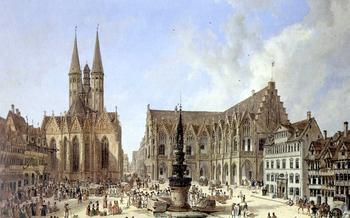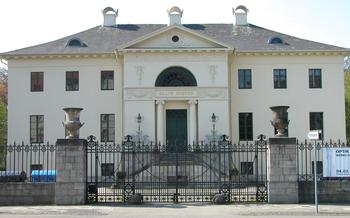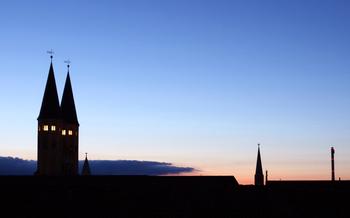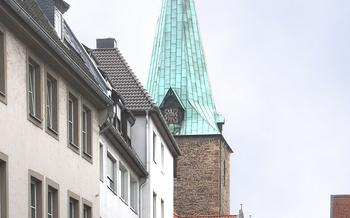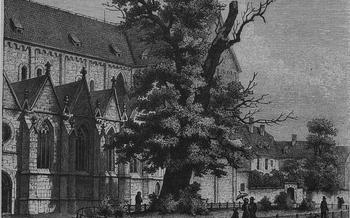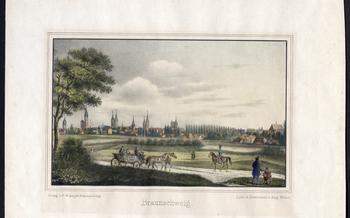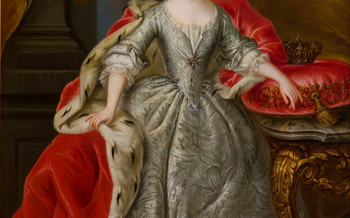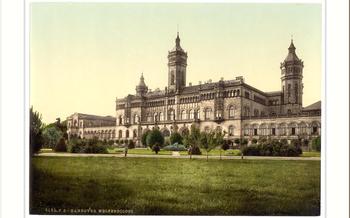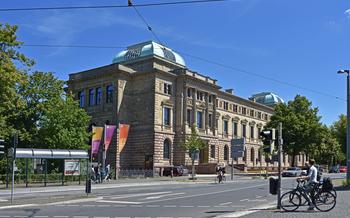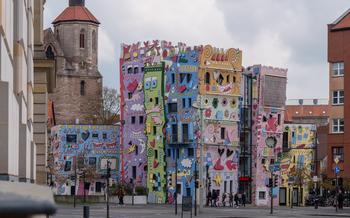
Burgplatz (Castle Square) with Dankwarderode Castle
- Henry the Lion Monument
- Braunschweig Cathedral
- St. Andreas Church
- Gewandhaus (Cloth Hall)
- Braunschweig City Hall
- Magniviertel (Magni Quarter)
- Herzog Anton Ulrich Museum
- Natureum Braunschweig: Exploring the Wonders of Natural History
- Insider Tip: Take a Guided Walking Tour
Henry the Lion Monument
Historical context
The Henry the Lion Monument, situated in the heart of Burgplatz, stands as a testament to the legacy of Henry the Lion, the illustrious Duke of Saxony and Bavaria who played a pivotal role in German history during the 12th century. A figure of immense power and influence, Henry's reign was marked by territorial expansion, political maneuvering, and a fierce rivalry with his cousin, Emperor Frederick Barbarossa.
Artistic significance
Created by prominent German sculptor Ernst Rietschel, the monument captivates with its intricate detail and expressive portrayal of Henry. Cast in bronze, the statue presents the duke in a commanding stance, his gaze fixed resolutely forward, embodying his unwavering determination and strength of character. The pedestal beneath features allegorical figures representing Henry's virtues and accomplishments, including justice, wisdom, and chivalry.
Symbolism and interpretation
The Henry the Lion Monument serves as a powerful symbol of Braunschweig's rich history and its enduring connection to this influential ruler. It represents the city's pride in its heritage and its appreciation for the contributions made by Henry during his reign. The monument's placement in Burgplatz, surrounded by other significant landmarks, further underscores its importance as a symbol of Braunschweig's identity.
Location and surroundings
The Henry the Lion Monument occupies a prominent position in Burgplatz, directly facing Dankwarderode Castle. Its central location ensures that it commands attention and serves as a focal point for visitors exploring the square. The surrounding area offers a harmonious blend of historical architecture, lush greenery, and vibrant public spaces, creating an ambiance that enhances the monument's significance and grandeur.
Braunschweig Cathedral
Braunschweig Cathedral, officially known as the Cathedral of St. Blasius, is a prominent landmark in the city of Braunschweig, Germany. It holds significant historical and religious importance and is renowned for its architectural beauty and interior highlights.
Architectural Features
The cathedral showcases a harmonious blend of Romanesque and Gothic architectural styles. Its exterior features intricate carvings, decorative portals, and a towering steeple that dominates the cityscape. Inside, visitors can admire the impressive vaulted ceilings, elegant stained glass windows, and ornate pillars that create a sense of grandeur and awe.
Historical Significance
Braunschweig Cathedral traces its roots back to the 11th century when it was founded by Henry the Lion, Duke of Saxony and Bavaria. Over the centuries, it has undergone several renovations and expansions, reflecting the changing architectural trends and the city's evolving religious and political landscape. The cathedral has witnessed significant historical events, including imperial coronations, religious ceremonies, and the Protestant Reformation.
Interior Highlights
The cathedral's interior boasts a wealth of artistic treasures and sacred artifacts. The highlight is the impressive bronze lion, known as the "Braunschweiger Löwe," which stands proudly in front of the altar. Created in the 12th century, this majestic sculpture is a symbol of the city and a testament to the skilled craftsmanship of the period. Other notable features include the elaborately carved pulpit, the intricate choir stalls, and the colorful frescoes that adorn the walls and ceiling.
Guided Tours and Events
Visitors can explore the cathedral's rich history and admire its architectural and artistic splendor through guided tours. These tours provide insights into the cathedral's construction, its role in religious and political life, and the stories behind its many treasures. Throughout the year, the cathedral also hosts various events, including concerts, exhibitions, and special religious services, offering visitors a chance to experience the sacred space in different ways.
St. Andreas Church
Gothic Elegance and Historical Significance
St. Andreas Church, an architectural masterpiece in the heart of Braunschweig, stands as a testament to the city's rich religious history. Built in the 13th century, this Gothic church boasts a striking silhouette that dominates the cityscape. Its intricate facade, adorned with delicate tracery and soaring spires, reflects the height of Gothic artistry.
Step inside to discover a breathtaking interior, where light streams through magnificent stained-glass windows, illuminating the intricate details of the vaulted ceilings. The church's elegant pillars and graceful arches create a sense of awe and inspiration, inviting visitors to contemplate the sacredness of this space.
St. Andreas Church has witnessed many significant events throughout its history. It was here that the Protestant Reformation took hold in Braunschweig, and the church played a crucial role in shaping the city's religious identity. The church's pulpit, adorned with intricate carvings, has been the stage for countless sermons and speeches that have influenced the hearts and minds of generations of Braunschweig residents.
Beyond its religious significance, St. Andreas Church is also renowned for its impressive collection of artworks. Visitors can admire the stunning altarpieces, intricate sculptures, and beautiful paintings that adorn the church's interior. Each piece tells a story, offering a glimpse into the rich cultural heritage of Braunschweig.
Join a guided tour to unravel the fascinating history and symbolism hidden within the walls of St. Andreas Church. Learn about the lives of the people who shaped this sacred space, the intricate construction techniques used to create its architectural wonders, and the significance of the artwork that adorns its interior.
Whether you're a history buff, an art enthusiast, or simply seeking spiritual inspiration, St. Andreas Church is a must-visit destination in Braunschweig. Its enduring beauty and rich heritage make it a captivating attraction that will leave a lasting impression on every visitor.
Gewandhaus (Cloth Hall)
Originally constructed in the 13th century, the Gewandhaus was a significant center for the textile trade, serving as a meeting point for merchants and a place for the sale of high-quality fabrics, contributing significantly to Braunschweig's reputation as a hub for textile production. Its Gothic architecture, featuring intricate carvings and a striking stepped gable, stands as a testament to the city's medieval heritage, capturing the essence of its rich history.
Today, the meticulously restored Gewandhaus serves a new purpose, housing the City Museum, which delves into Braunschweig's fascinating past. Through captivating exhibits, visitors can embark on a journey through the city's history, exploring its medieval origins, its role in the Hanseatic League, and its flourishing cultural and economic achievements over the centuries. The museum's collection boasts an impressive array of artifacts that bring Braunschweig's rich heritage to life, providing a glimpse into the lives of its people and the forces that shaped the city's destiny.
In addition to its historical significance, the Gewandhaus also serves as a vibrant venue for various exhibitions, cultural events, and festivals, further enhancing its role as a hub for community engagement and artistic expression. Its central location in the heart of the Altstadtmarkt square makes it a focal point for both locals and visitors, inviting them to discover the diverse cultural offerings that Braunschweig has to offer.
Braunschweig City Hall
Historical Background
The Braunschweig City Hall stands as a testament to the city's rich history and civic pride. Its origins can be traced back to the 13th century when the city's council sought to establish a central location for their meetings and administrative duties. The initial structure was a modest building, but over time, it underwent several expansions and renovations, reflecting the city's growing prosperity and political significance.
Architectural Details
The current City Hall building, completed in the 15th century, is an impressive example of Gothic architecture. Its intricate facade features pointed arches, delicate tracery, and numerous sculptures depicting historical figures and scenes. The building's two towers, known as the "Lewen" (Lion) and the "Adler" (Eagle), symbolize the city's independence and its affiliation with the Holy Roman Empire.
Public Functions and Events
The City Hall remains the seat of Braunschweig's municipal government, housing the offices of the mayor and the city council. It continues to serve as a venue for official ceremonies, public meetings, and special events. The building's spacious interior includes several halls and chambers, each adorned with historical paintings, tapestries, and sculptures.
Guided Tours and Accessibility
The Braunschweig City Hall is open to the public for guided tours, offering visitors an opportunity to explore its magnificent interiors and learn about its historical significance. The tours provide insights into the building's architecture, its role in the city's governance, and the stories that have unfolded within its walls. The City Hall is conveniently located in the heart of Braunschweig's Altstadt (Old Town), making it easily accessible on foot or by public transportation.
Magniviertel (Magni Quarter)
The Magniviertel, also known as the Magni Quarter, is a charming neighborhood located in the heart of Braunschweig, Germany. With its rich history, well-preserved architecture, and vibrant atmosphere, this quarter offers visitors a unique and immersive experience.
Historical Charm:
The Magniviertel's history dates back to the Middle Ages, when it was home to merchants, artisans, and craftsmen. The quarter was named after St. Magni, the patron saint of Braunschweig, whose church (St. Magni Church) is located in the heart of the neighborhood.
Half-timbered Houses:
One of the most distinctive features of the Magniviertel is its abundance of half-timbered houses. These traditional German houses, with their intricate wooden beams and plastered walls, add a unique charm to the neighborhood's streets. Many of these buildings have been carefully restored and now house shops, cafés, and restaurants.
Boutiques and Cafés:
The Magniviertel is a popular destination for shopping and dining. The quarter is home to a variety of independent boutiques, offering everything from handmade crafts to vintage clothing. There are also numerous cafés, bars, and restaurants, where visitors can relax and enjoy a meal or a drink.
Cultural Events and Festivals:
The Magniviertel is a vibrant cultural hub, hosting various events and festivals throughout the year. The annual Magniviertelfest, held in August, is a popular celebration that features live music, food stalls, and family-friendly activities. The quarter also hosts regular art exhibitions, concerts, and theater performances.
Herzog Anton Ulrich Museum
A Treasure Trove of Art and History
Immerse yourself in the rich cultural heritage of Braunschweig at the Herzog Anton Ulrich Museum, a renowned institution that houses an impressive collection of art and historical artifacts. Founded in 1754, the museum boasts a diverse array of masterpieces spanning various eras and genres.
Art Collections
The museum's extensive art collection includes paintings, sculptures, drawings, and prints from the Middle Ages to the present day. Admire works by renowned artists such as Albrecht Dürer, Lucas Cranach the Elder, and Hans Holbein the Younger, whose contributions have shaped the course of art history.
Historical Artifacts
Delve into the depths of Braunschweig's past through the museum's collection of historical artifacts. Discover intriguing objects that tell the story of the city's development, from prehistoric tools and medieval manuscripts to royal regalia and domestic items from bygone eras.
Special Exhibitions
The Herzog Anton Ulrich Museum regularly hosts special exhibitions that explore specific themes or showcase the works of particular artists. These temporary displays offer a fresh perspective on the museum's collection and provide an opportunity to delve deeper into specific areas of interest.
Guided Tours and Workshops
Enhance your visit to the Herzog Anton Ulrich Museum by joining a guided tour led by knowledgeable docents. These tours provide insightful commentary on the museum's highlights and offer a deeper understanding of the artworks and historical artifacts on display. Additionally, the museum offers educational workshops and programs for visitors of all ages, fostering a love of art and history in the community.
Natureum Braunschweig: Exploring the Wonders of Natural History
Natureum Braunschweig is a captivating natural history museum that invites visitors to delve into the fascinating world of nature and its diverse inhabitants. Situated in the heart of the city, this modern museum boasts a remarkable collection of exhibits that showcase the region's rich biodiversity and the intricate workings of the natural world.
Step inside and embark on an educational journey through interactive displays, captivating exhibitions, and immersive dioramas that bring the wonders of nature to life. Discover the incredible diversity of plant and animal species that call Braunschweig and its surroundings home, from majestic birds soaring through the skies to tiny insects crawling amidst the undergrowth.
At Natureum Braunschweig, hands-on experiences and interactive exhibits make learning about nature both fun and engaging. Explore the wonders of the microscopic world through interactive microscopes, marvel at the intricate beauty of butterflies in the butterfly garden, and come face-to-face with life-size replicas of extinct creatures that once roamed the Earth.
Families with children will particularly enjoy the museum's dedicated children's area, where little ones can unleash their curiosity and explore nature through play and interactive games. Learn about the importance of conservation and sustainability, and gain a deeper understanding of the delicate balance that sustains our planet.
Whether you're a nature enthusiast, a curious explorer, or simply looking for a fun and educational day out, Natureum Braunschweig offers a captivating experience that will leave you inspired and amazed.
Insider Tip: Take a Guided Walking Tour
To truly delve into the rich history and culture of Braunschweig, consider joining a guided walking tour. These tours, led by knowledgeable local guides, offer a unique perspective and immersive experience. As you stroll through the city's charming streets and hidden corners, your guide will regale you with fascinating stories and anecdotes about the city's past and present.
Discover the hidden gems that often go unnoticed by visitors, such as the picturesque courtyards, medieval alleyways, and lesser-known landmarks. Learn about the city's famous personalities, including Henry the Lion and Carl Friedrich Gauss, and their contributions to Braunschweig's legacy.
With a guided walking tour, you'll gain a deeper understanding of Braunschweig's architectural heritage, from the Romanesque grandeur of the cathedral to the Gothic elegance of St. Andreas Church. Your guide will point out intricate details and symbols that you might otherwise miss, enriching your appreciation for the city's architectural wonders.
To make the most of your Braunschweig experience, book a guided walking tour with a reputable tour operator. Several companies offer a variety of tours tailored to different interests and durations. Whether you prefer a comprehensive overview or a more focused exploration of a particular theme, you're sure to find a tour that suits your preferences.
So, lace up your walking shoes, embrace the spirit of discovery, and let a knowledgeable guide lead you through the captivating tapestry of Braunschweig's history and culture.
